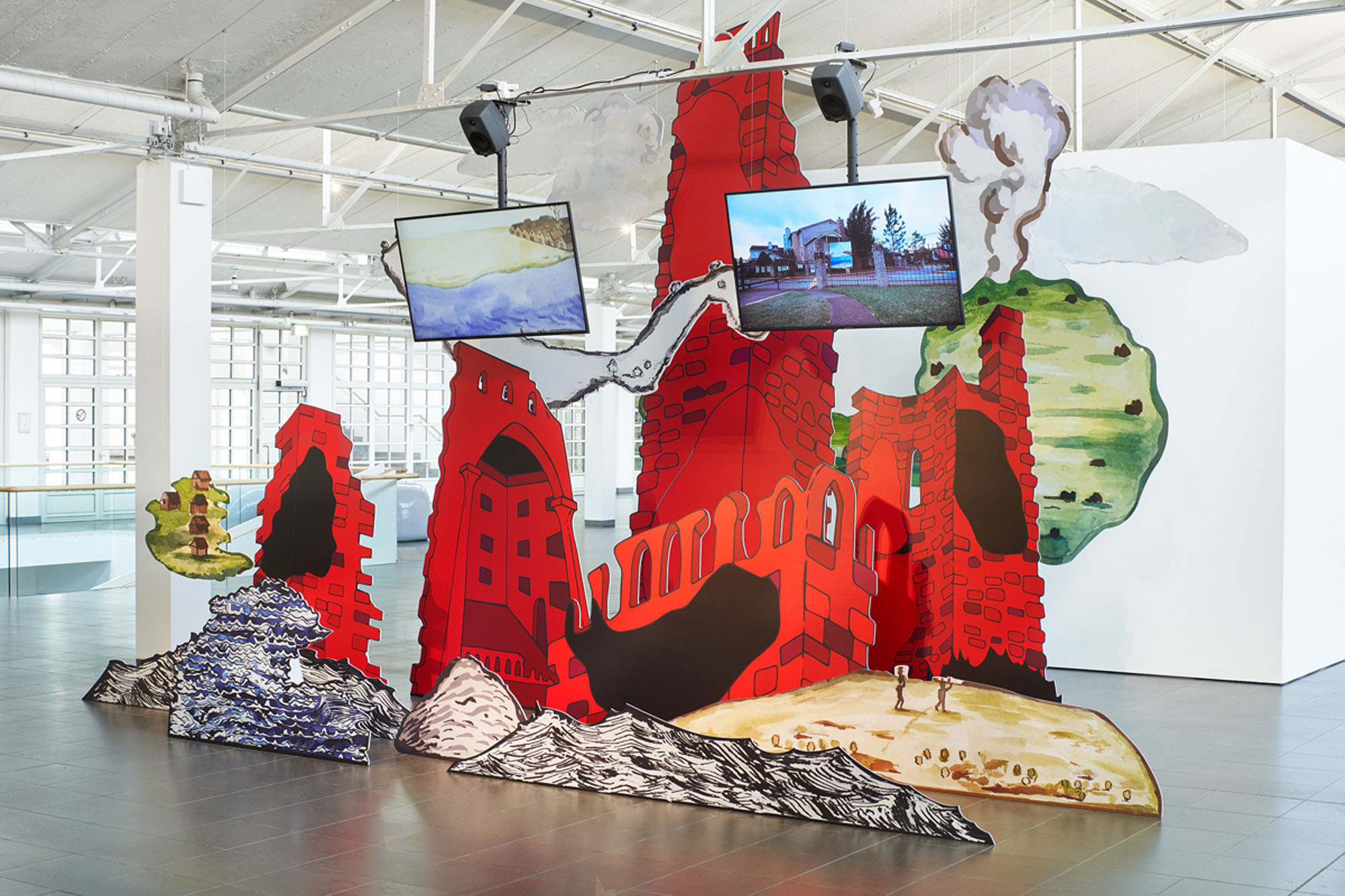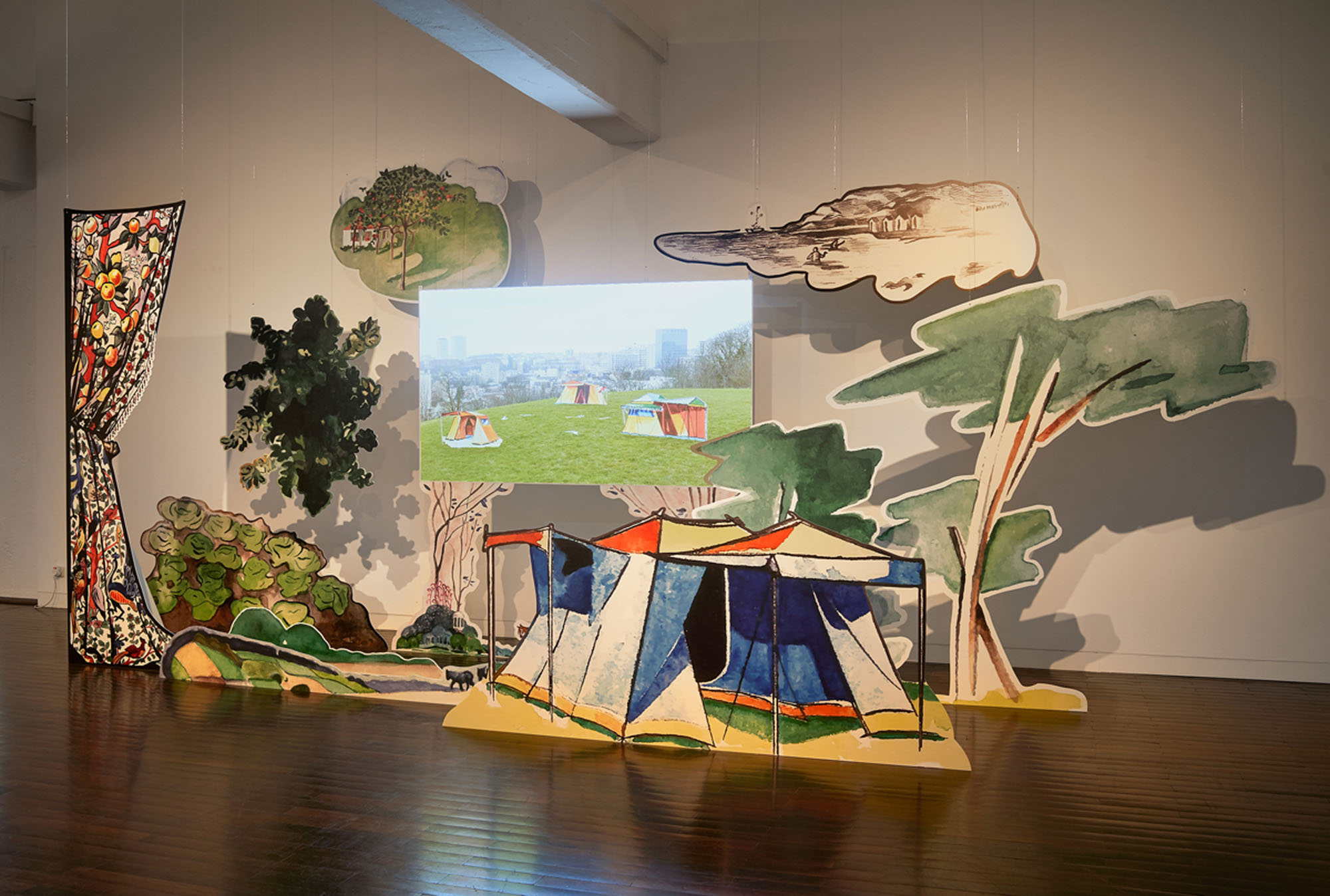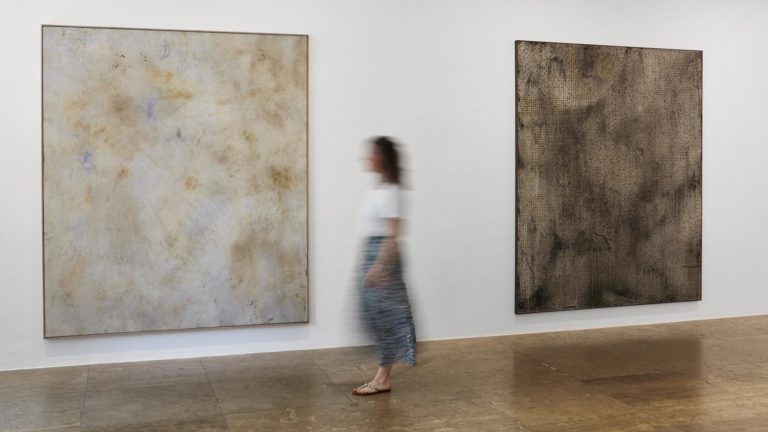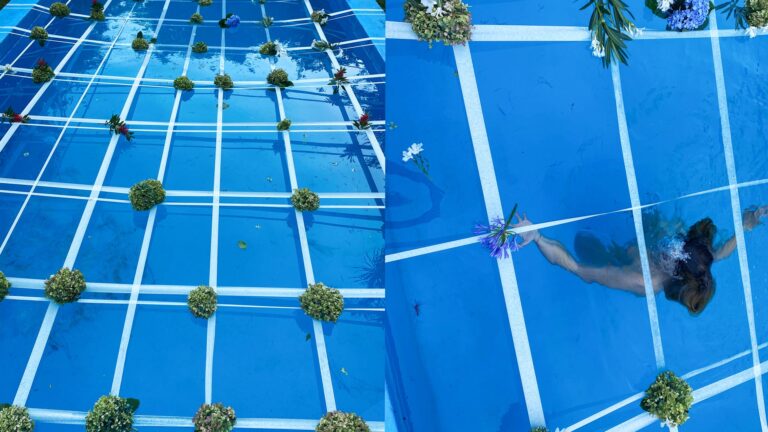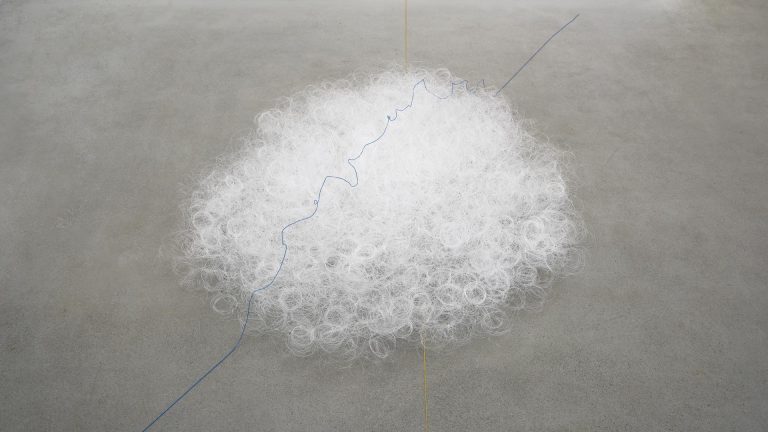Artist: Danielle Dean
Exhibition title: Trigger Torque
Curated by: Holger Otten
Venue: Ludwig Forum Aachen, Aachen, Germany
Date: November 15, 2019 – March 1, 2020
Photography: all images copyright and courtesy of the artist and Ludwig Forum Aachen
In her artistic work, Danielle Dean grapples with the construction of ethnic, social, and gender-specific roles by examining the narratives she finds in political speeches and news items for example, as well as in advertising and popular culture. The artist focuses in particular on the power structures underlying these narratives, which lead to the manipulation of thoughts, feelings, and social relationships.
The artist subverts the visual language of advertising and marketing and transfers it to an artistic space where the line between fact and fiction is blurred. The starting point for her video installations, collages, and drawings are certain objects, events, and locations which Danielle Dean uses to demonstrate that certain forms of invasion, violence, and surveillance operate across geographical and temporal boundaries.
With Trigger Torque , Danielle Dean (b. 1982 in Huntsville, Alabama, USA) presents her first exhibition in Germany at the Ludwig Forum for International Art. Alongside new works for Aachen entitled Fordland (2019), she is also showing two additional large works: Bazar (2018) and True Red Ruin (2017).
The British-American artist received her BA from Central Saint Martins in London (2006) and MFA from California Institute of the Arts (2012) in Valencia. She has been a fellow of the Whitney Museum of American Art’s Independent Study Program in New York and a resident at Museum of Fine Arts in Houston and Rijksakademie van Beeldene Kunsten in Amsterdam. She has held solo exhibitions at The Museum of Contemporary Art Detroit (2018), 47 Canal, New York (2018), Commonwealth & Council, Los Angeles (2017) and Studio Museum in Harlem, New York (2016). Works by the artist can be found in the collections of the Whitney Museum of American Art, New York City, Hammer Museum, Los Angeles, The Museum of Fine Arts, Houston, and Stedelijk Museum Amsterdam. Danielle Dean lives and works in San Diego, California.
Curated by Holger Otten
Fordland (2019)
While carrying out research in the Ford Motor Company archives in Detroit, Danielle Dean found advertisements produced by the car manufacturer from the early twentieth century to the present day. What they all have in common is that the landscape in which the advertised cars are presented is ideologized in line with the American Dream and its lifestyle. Yet what remains when the car is removed from the image, and one looks behind the glossy scenes of the advertising world? The artist has deconstructed and then delicately reassembled the original source material. Instead of the idyll depicted in the original advertisements, this artistic interpretation illustrates an alternative perspective that reflects the working conditions and environmental consequences of the automotive industry.
At the center of the complex work, made up of objects and drawings in which the artist has adapted the aesthetics of Ford’s advertisements, is an animated film entitled Low Long Line. Here Danielle Dean has made use of the so-called multiplane camera technique, where a perspectival image is separated into consecutive layers to create a realistic 3D effect. Developed extensively by Disney Studios in the 1930s for their animated films, this technique was a crucial aspect of the industrialization of advertising.
Danielle Dean’s animation combines features such as advertisements from 1910 to 1940 with individual architectural elements from the company’s former headquarters in Detroit, built by the famous industrial architect Albert Kahn, and “Fordlandia,” a 10,000-square-kilometer region of the Amazon rainforest that was deforested in order to construct rubber plantations for the production of tires.
Bazar (2018)
Danielle Dean’s video installation Bazar (2018) was conceived during the time she spent in the archives of the Bazar de l’Hôtel de Ville (BHV), which has been regarded as one of the leading department stores in Paris ever since it was founded opposite the Hôtel de Ville in 1856, and which is now a member of the Galeries Lafayette Group. Legendary in Parisian retail folklore, Duchamp bought his Bottle Rack readymade here in 1914.
Danielle Dean worked with women from Permis de Vivre la Ville to create her installation, an association that promotes social and cultural engagement in the banlieues (suburbs) of Paris. Many of these women are second-generation descendants of immigrants from former French colonies in Africa and Oceania. Together with the artist they analyzed BHV’s retail catalogues from the 1880s to the present day. Over the years these catalogues have consistently exemplified a certain ideal of the French people that are strikingly white, upper middle class, and Parisian. The sole image of a black woman encountered by the reading group in BHV’s catalogues was a maid who had obviously been depicted to make bed sheets appear whiter.
From these catalogues and discussions about consumerism and colonialism Danielle Dean developed a script for her video work, in which, with a dash of humor, the workshop participants appear in semi-improvised scenes alongside animated images inspired by illustrations from the catalogues. The animated work is then physically extended into the space through a sequence of displays—cutout standees of items from BHV’s catalogues. These create a “romantic” commercial environment and constitute a physical and conceptual framework for the video work.
True Red Ruin (2017)
True Red Ruin is set in Cuney Homes, a housing complex in the Third Ward, Houston (Texas, USA), a predominantly African-American district affected by forced gentrification, which is gradually displacing its long-established residents. A second location serves as a historic backdrop for the artist: Elmina Castle in Ghana, a World Heritage Site and the oldest European building south of the Sahara. Built in 1482 by the Portuguese as a trading post, it then became a major hub of the transatlantic slave trade. By overlaying these two places and their narratives, the artist shows that certain forms of invasion, violence, and surveillance are active across geographic and temporal boundaries to this day.
Born to a Nigerian-American father and raised by her mother in the suburbs of London, Danielle Dean appears in her film as the manager of the new Elmina Castle; her half-sister and her friends—who also live in Cuney Homes in real life—play the local inhabitants. They are sometimes optimistic in their encounters with the manager and at other times they divulge their worst fears, which are par tially based on current and historical sources. Interestingly, there are a number of parallels here to the original historical model. During the construction of the fortifications in the fifteenth century, the Portuguese also tried to appease the incensed local population with empty promises such as the promotion of local trade, the creation of jobs, and protection against threats. A resistance movement formed nonetheless; it was violently crushed by the Portuguese. Whether the residents’ protests about the so-called “New Elmina Castle” in the video will be successful remains unanswered. Ultimately, the question arises for them—and consequently also for the viewers—as to whether a society can escape its history when shaping its future.
As an obvious historical reference, the artist uses stand-up displays in the video installation with images of Elmina Castle that are reminiscent of graphic novels—blood-red wall fragments that give the installation its name: True Red Ruin . These easy-to-move “product displays” find their counterpart in the prefabricated building components that the Portuguese brought to West Africa in order to build their fortress in the shortest amount of time possible, thus presenting the local population with a fait accompli as quickly as possible. In this way, the artistic work creates a bridge between the structures of production and (human) trade that were already globalized at the time.
Meanwhile, as a protagonist in the video work, the artist consciously places herself in a difficult position: an African-American in the role of the manager who is supposed to win over the local population regarding the construction of the “New Elmina Castle.” Not only does Danielle Dean negotiate the historical conditioning of power structures against the backdrop of a continuous physical and mental colonization, she also reflects on our and her own involvement in a postcolonial world.
Danielle Dean, Trigger Torque, 2020, exhibition view, Ludwig Forum Aachen, Aachen
Danielle Dean, Trigger Torque, 2020, exhibition view, Ludwig Forum Aachen, Aachen
Danielle Dean, Trigger Torque, 2020, exhibition view, Ludwig Forum Aachen, Aachen
Danielle Dean, Trigger Torque, 2020, exhibition view, Ludwig Forum Aachen, Aachen
Danielle Dean, Trigger Torque, 2020, exhibition view, Ludwig Forum Aachen, Aachen
Danielle Dean, True Red Ruin (Elmina Castle), 2017, two-channel HD video installation, standees, 9:39 min, Courtesy Commonwealth and Council, Los Angeles, Photo: Alwin Lay
Danielle Dean, True Red Ruin (Elmina Castle), 2017, two-channel HD video installation, standees, 9:39 min, Courtesy Commonwealth and Council, Los Angeles
Danielle Dean, Long Low Line, 2019, HD video animation, 15:00 min, Courtesy the artist, Photo: Alwin Lay
Danielle Dean, Long Low Line, 2019, HD video animation, 15:00 min, Courtesy the artist, Photo: Alwin Lay
Danielle Dean, Long Low Line, 2019, HD video animation, 15:00 min, Courtesy the artist, Photo: Alwin Lay
Danielle Dean, Bazar, 2018, four-channel HD video installation, standees, 10:34 min, Collection of Patrick & Lindsey Collins, Photo: Alwin Lay
Danielle Dean, Bazar, 2018, four-channel HD video installation, standees, 10:34 min, Collection of Patrick & Lindsey Collins
Danielle Dean, Trigger Torque, 2020, exhibition view, Ludwig Forum Aachen, Aachen
Danielle Dean, Asset (Strato-Star, Ford, 1952), 2019, gouache on board, car stickers, aluminium frame, Courtesy the artist, Photo: Alwin Lay
Danielle Dean, Asset (American Road!, Ford, 1952), 2019, gouache on board, car stickers, aluminium frame, Courtesy the artist, Photo: Alwin Lay







